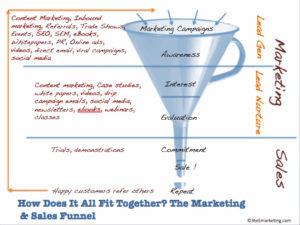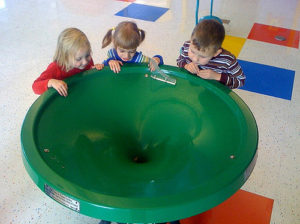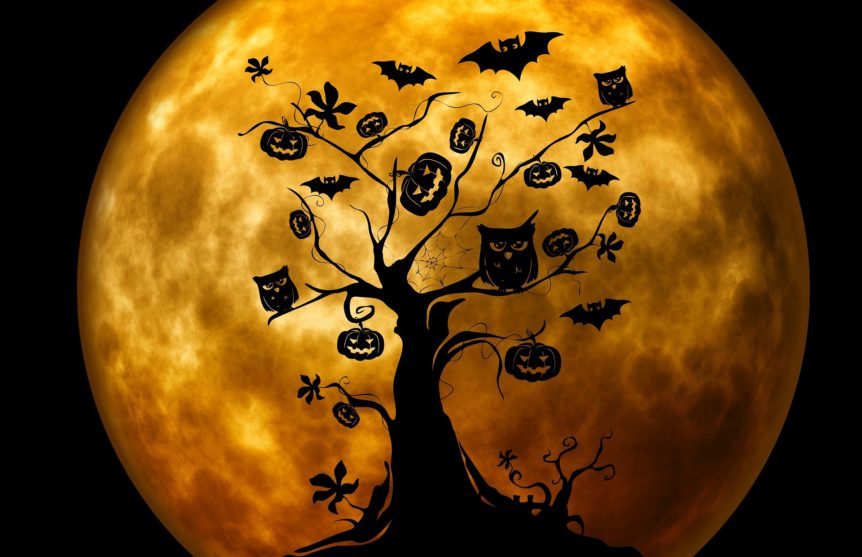This is part of a recurring series during the month of October where we will teach you our best tactics for using retargeting and other highly-targeted ads to hone in on your ideal customer segment and deliver them what they want, possibly even before they even know they want it! Have an idea for a future post? Let us know in the comments and we will do our best to get to it!
In this installment of our Mischief Month series, we are looking at the buying cycle that a customer goes through on the way to purchase and discussing how that fits in to your marketing funnel. We talk about using retargeting to help push the customer further along into the funnel once we identify their location along the cycle, and we get up to a little mischief by using this data to serve your customer the right purchase trigger at just the right time using Facebook retargeting ads.
What are the Components of the Marketing Funnel?
 First up, let’s talk about the marketing funnel and the journey that a buyer (generally) must travel through before they become a purchaser. We can divide up the funnel into three sections: Lead Generation, Lead Nurture, and Sales. Check out the graphic for a nice illustration of this. Each section represents various marketing activities that you as the business should be undertaking to guide the buyer from one section to the next.
First up, let’s talk about the marketing funnel and the journey that a buyer (generally) must travel through before they become a purchaser. We can divide up the funnel into three sections: Lead Generation, Lead Nurture, and Sales. Check out the graphic for a nice illustration of this. Each section represents various marketing activities that you as the business should be undertaking to guide the buyer from one section to the next.
The first section, Lead Generation, is made up of the Awareness section of the buyer’s journey. They have to know that you exist in order to buy from you, right? So that’s the goal. Any activity that let’s the customer know that you are open for business fits in this section and the goal is simply to make the customer aware of that fact. Things like content marketing, social media, referrals, email, and even events/conferences all go into this top part of the funnel.
The middle section of the funnel, Lead Nurture, is comprised of the Interest and Evaluation stages of the buyer’s journey. Now that they know you exist, they have to decide if they want to continue interacting with you at all. For instance, perhaps a prospective buyer saw your Facebook ad and decided they want to check out your page some more. They hit the awareness phase and moved into the interests phase. Now they will do some research on you to see if they want to continue interacting. This is where things like case studies, ebooks, webinars, white papers, and videos all come into the spotlight.
Show the customer why they should care and continue to interact with you.
As the customer moves from simple interest into evaluation, this is where the substance of your brand really matters. Are you just a pretty face with a good tagline, or do you have some real expertise that you can show off that will show them that you are the real deal? Prove your worth to them as a business and they will continue down the buyer path.
The last section is, of course, the section we all love: the Sale. The customer at this point has become aware of your existence, interested in your brand, they did their research and decided that you are an authority and have the solution to their problem, and now they are ready to make a commitment to you or your product. In the case of e-commerce this might simply be a sale from your website, or if you are a service provider then it could be a scheduled consult. Pushing the buyer from the evaluation phase to the commitment/sale phase is relatively hands-off (unless you require demonstrations or consults to close the sale), and provided that you have positioned your business correctly and marketed with authority- they will naturally fall down the funnel to this stage.
What are the Components of YOUR Marketing Funnel?

What Does your Funnel Look Like?
It really doesn’t do us any good to discuss all the parts of the funnel and then give you a strategy without first talking about how this fits into your specific business.
So the first thing to do here, is to talk about how this all fits into YOUR business, and identify the components of YOUR marketing funnel. This could be as simple as going through your business with the descriptions of the funnel sections from above and penciling in all your marketing activities in the appropriate sections, or it could be that you are drawing out your strategy from scratch and need to plan out what activities that you want to undertake. In the latter case, you can use this illustration of the funnel as a guide for which kinds of activities are most appropriate to your business and how they all interact with one another.
Since we are heading toward using all of this in a retargeting campaign, we need to talk about buying triggers. What are the things that will cause someone to head further down the funnel? Surprisingly, this is something that most business owners never even consider. With about 98% of visitors visiting a website to never end up purchasing is only proof that there is tons of revenue left on the table for you to pick up. Buying triggers can be anything from a beautiful video of someone’s vacation shot on a GoPro served to someone who is currently on or just returned from a vacation, to an ad for a spacious three bedroom house served to an expecting couple. We want to evoke some kind of emotion that is tied to an event relevant to the buyer. It could be as simple as calling attention to a recent life event as above, or revealing to the customer a pain that they have but had forgotten about.
Identifying Buying Triggers
The first step in identifying buying triggers is to identify and create you buyer persona. Who is your ideal client/customer? What do they do for a living? What is their occupation? What do they do on the weekends? Creating this persona and making them as real as possible will not only let you identify the relevant buying triggers, but will be invaluable when you go to create the ad copy later on. If you already have an established customer flow then perhaps you could model your personas after some of your current customers to make them even more realistic.
Now that we have an image for who your buyer is, what makes them purchase something? Are they an impulse buyer who responds to ‘Keeping up with the Joneses’ marketing or are they someone who needs to do all of their research before purchasing? Have they recently gone on a holiday somewhere that your product could evoke images of? Do they have a searing pain that you can press and then offer a solution for? Start asking questions to understand why that person makes a purchase decision and then…
Determine how to manufacture that trigger, or how to help that persona recognize that the trigger occurred.
How Can We use This to Create Targeted and Powerful Messaging?
Now for the million dollar question: How does all this fit into a retargeting campaign that keeps prospects moving through the marketing funnel?
When we started this article we began with the idea that we could use retargeting to read your customers minds and now we are going to work all this together and answer just exactly how that happens.
This journey started with identifying the customer journey and outlining how it plays into the marketing funnel. Well, once we have gone through this entire process of not only outlining those journeys, but also of who your ideal customer is, and what makes them commit to a purchase; we can then use that information to segment your entire audience by which section of the funnel/journey they are in and then create eerily relevent marketing to help that segment from where they currently are into the next section of the funnel.
For instance:
Let’s say we have identified a cohort of potential customers who have visited your website after interacting with your social media accounts, but did not purchase anything. We know that this cohort has already passed through the Awareness phase and possibly even the Interest phase, and most likely are sitting in the Evaluation section of the funnel. They have already decided that you were worth investigating further but for some reason have not yet made a purchase or scheduled a consult. What can we do to help them along?
Well from our buyer personas we have an idea of what they are interested in, and we know what kinds of events are likely to cause them to make a purchase; so perhaps we could deliver a targeted ebook or video to this cohort to help them evaluate your company and position yourself as the expert above your competition. Or, perhaps you are selling products and know that travel is a buying trigger; you could deliver a targeted offer to people who have recently or are currently traveling. These kinds of campaigns can be done with retargeting and location preferences in Facebook when setting up an ad.
Another example might be a group of potential customers who liked a post shared by your Facebook page, but never visited your website. Because of your buyer personas you can probably identify what about that post piqued their Interest and create a similarly-relevant ad or post that re-engages that audience and brings them back to your page for more information. This would effectively re-activate the Awareness segment if they were no longer aware of your brand, or move them further down the funnel from simple Awareness to Interest or Evaluation.
The main purpose of this article was not so much to provide a How-To instructional guide regarding building the ads themselves, but to help you understand the journey that your customer is taking so that you can create a hyper-relevant campaign that will deliver just the right message at just the right time, to help them move down the funnel to purchase. If executed correctly, the customer will not even notice that they are being led down this path and instead simply think that your marketing is incredibly relevant at just the right time in their lives.
Have more ideas for Mischief Month posts that you’d like to see us write on? Have thoughts on this post? Let us know in the comments and you might just see your topic coming up in a future week.

